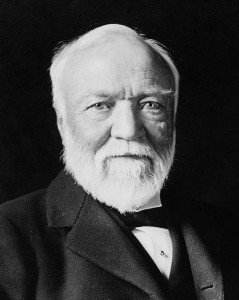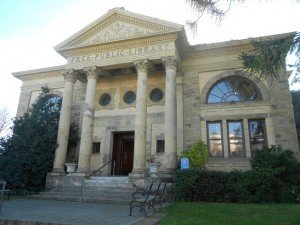Thank you for reading this post, don't forget to subscribe!
The story of the Carnegie Libraries details one of the more interesting philanthropic endeavors the United States has ever experienced. It’s under reporting may be due to the fact it occurred so long ago and many of today’s generation may not even be aware of it.
Thousands of Libraries Built

Between the years of 1883 and 1929 no less than 2,500 libraries were established thanks to the donations from Andrew Carnegie and steel. By the year 1919 nearly one half of all the public libraries in the U.S. were erected due to Andrew Carnegie’s efforts. The Carnegie Library structures were often times the most impressive buildings in town as the photos in this article demonstrate.
A Fortune from Steel
Andrew Carnegie was born in Scotland and emigrated to the U.S. with his parents in 1848. Working first as a telegrapher and later as a bond salesman, he made wise investments in railroads and other emerging industries and amassed wealth.
Those of us who know the biography of Andrew Carnegie realize that his fortune was derived from the the emerging steel industry of the 1800’s. In America, Andrew Carnegie and steel were much the same thing. Andrew Carnegie began producing steel in the 1870’s and after acquiring additional mills formed the Carnegie Steel Company in Pittsburgh in 1892. The company was sold to U.S. Steel in 1901.
The Carnegie Formula
Almost all of Carnegie’s libraries were established were built by what was called “The Carnegie Formula“. Simply, this meant that the town that was to receive a donation from Andrew Carnegie would have to also make a financial commitment to the project. In other words, the grant from Carnegie would be augmented by money from the community itself. Carnegie felt strongly that by having the community financially involved would maintain their keen interest in it’s implementation.

The Carnegie Formula was fairly simple. Communities were required to show a real need for a library, provide land for it’s construction, make it’s use free for to the general public and contribute ten percent of the construction costs. Money donated from Carnegie was distributed piecemeal as the project moved forward. Often towns needed to arrange added taxes to raise their ten percent stake.
The Impact of the Carnegie Libraries
Today, public libraries are essentially a given. Most communities have them and we generally take them for granted. This wasn’t the case at the turn of the twentieth century. In many cases the Carnegie Libraries represented the first time people could freely browse over books and periodicals. Both the rich and poor could have free access to literary material. They could learn on their own and do it for free. This was a big deal during the early years of free libraries. Prior to that, a seeker of free reading material would often need to ask a clerk to search for the title in a closed book collection. As a result, the new and easily accessible Carnegie Libraries were often the town’s cultural center.

If you look at the years when the Carnegie Libraries project were unfolding, these corresponded closely with the period when towns and cities were realizing great growth. Although Carnegie Libraries were built all over the nation, newly thriving western towns were major beneficiaries of the steel magnate’s philanthropy. The libraries were built in the decades immediately following the last of the western Indian Wars and population was streaming westward like never before.
Links to two additional Trips Into History articles you’ll enjoy include;
World War Two Attacks on America’s West Coast
Some of the Old Carnegie Library Buildings we’ve Visited in the West
From the few photos featured in this article, you can clearly realize that the Carnegie Library buildings appeared quite impressive. The Carnegie Libraries today are utilized for a variety of purposes, mostly historical related including as local museums. Visiting one of the old Carnegie Libraries when visiting a community usually will fill you in about the town’s past. If the town you visit happens to have an old Carnegie Library you would be wise to add it to your trip planner.

The Carnegie building located in Livermore California is now home to the Livermore Heritage Guild. The address is 2155 Third Street. Carnegie Library funds were requested in 1908 and $10,000 was granted in 1909. The construction was completed in 1911. The architecture is Classical Revival.
The old Carnegie Library located in Healdsburg California, a short distance north of San Francisco and in the beautiful Sonoma County wine country, was built in the Neo-Classical Revival style. Today this building houses the Healdsburg Museum. A total of four Carnegie Libraries were constructed in Sonoma County. The museum address is 221 Matheson Street.
The Carnegie Library building in Petaluma California, a relatively short drive north of San Francisco, is now a very interesting local museum. The building is now called the Free Public Library of Petaluma, the Carnegie Free Library and the Petaluma Historical Library and Museum. Construction began in 1904 in the Classical Revival style. The library and museum is located at 20 Fourth Street .
(Photo of Andrew Carnegie is from the public domain. Remaining photos of Carnegie Libraries are from author’s private collection)
Take our fun twenty-five question History Quiz
